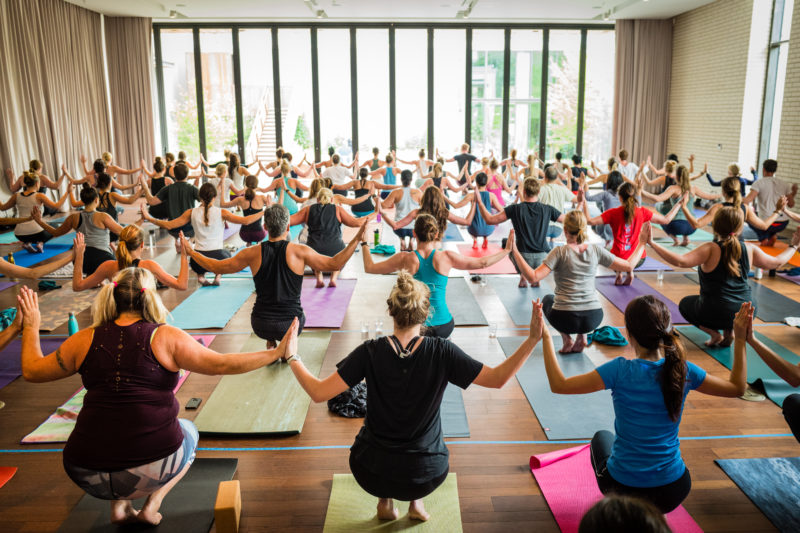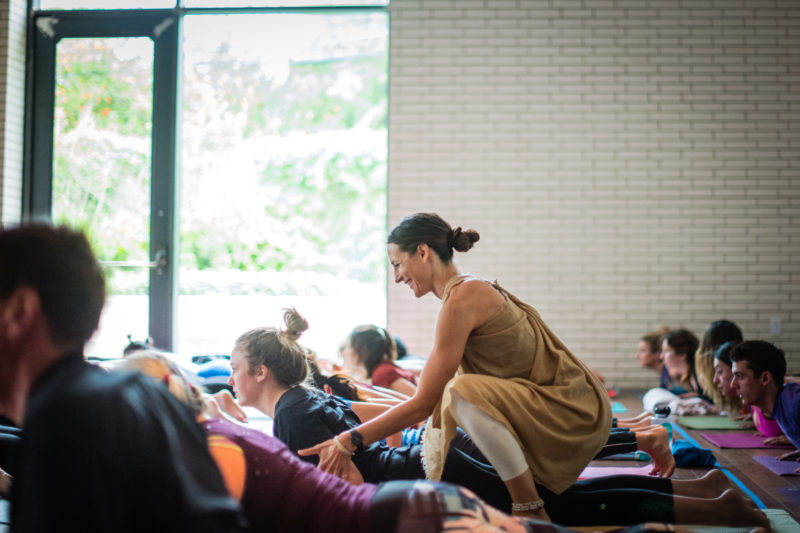Divine Downward Dog? Yoga Joins Church as Sunday Mode of Reflection
By Kaitlin Reid
Photography By Neil Gandhi
Reporting Texas

People gather in a yoga and meditation practice at South Congress Hotel for Wanderlust Yoga’s Sunday Ritual experience. Photo courtesy of Neil Gandhi.
It’s 4 p.m. on a Sunday afternoon at BFree Yoga Austin. Tiffany Winters closes her eyes, takes a breath and steps to the top of her mat. For the next 90 minutes, she allows herself to focus, slow down and unwind.
Initially, Winters, a 21-year-old University of Texas corporate communications junior raised in a Methodist household, struggled to fit the weekly class into her schedule. During her freshman year, the demands of her course load and on-campus involvement forced her to choose between church and her favorite yoga class during her free time each Sunday.
Now, every week, she chooses yoga.
For some, yoga is simply part of a well-rounded fitness regimen. Gyms list it alongside spin classes, and certain studios incorporate cardio intervals and weight lifting into hip-hop-infused classes.
But yoga and meditation also can act as viable substitutes for traditional religion.
The individualized, practice-oriented and inclusive approaches of yoga and meditation offer time for self-reflection, to cultivate a so-called best self and to disconnect from a connected world. More people today seem to replace traditional religious practices with more spiritual ones, such as meditation and yoga.
In a 2012 Pew Research Center report, 37 percent of Americans classified themselves as “spiritual,” but not “religious,” and one-fifth reported holding no religious affiliation at all –– the highest percentages ever recorded in Pew polling.
At the same time, practices such as yoga and meditation are on the rise: About 36.7 million Americans practice yoga. That’s an increase of 16.3 million people since 2012 –– roughly the population of Los Angeles –– according to a report conducted by Yoga Journal and Yoga Alliance.
Erin Johnston, a postdoctoral fellow at Stanford University who studied the intersection of religion and yoga at an Integral Yoga studio and a Catholic spiritual center, said some people are replacing traditional religious practices with yoga and meditation.
People who use yoga and meditation as spiritual practices, in place of formal religious practices, tend to maintain an anti-institutional outlook — especially in terms of religion, Johnston said. The practices appeal more to this demographic because they aren’t associated with the controversial political histories of most major religious institutions and because the practices are customizable — contradicting the structure of organized religion.
“You personalize it to what you want,” Winters said. “That’s the beauty of it. I use it as a time of undisturbed prayer, and I think anyone can do that.”
Kate Waitzkin, a teacher at Wanderlust Yoga Austin, said yoga is “filling a cultural void” for some people.
“I wouldn’t say that yoga has become popular because of the decrease in religion in any way, but I do think that it is potentially creating a space for those people who are looking for that sense of connection in a way that they’re not getting through church anymore,” she said.
Waitzkin and Wanderlust Yoga host a monthly “Sunday Ritual” experience to meet this demand for a deeper connection. Held at the South Congress Hotel and sponsored by Outdoor Voices, it allows people to come together and take part in an experience of gratitude and reflection, Waitzkin said.
And, apparently, people really want that too.

Kate Waitzkin adjusts a student’s form at Wanderlust Yoga’s Sunday Ritual yoga series. Photo courtesy of Neil Gandhi.
Using a vinyasa style of practice, which Waitzkin says “implies a sacred quality of movement and breath” because it directly translates to “place in a special way,” Waitzkin leads 100-plus practitioners through 75 minutes of practice with 50 minutes of movement, 10 minutes of rest and 15 minutes of guided breath and meditation. Afterward, attendees mingle, check out the hotel’s restaurants and listen to live music to solidify a classic Austin experience.
This isn’t the only way Wanderlust Yoga attempts to meet the growing demand for more spiritual practices.
When it opened five years ago, Waitzkin said, the studio did not offer any meditation classes, although some teachers probably incorporated aspects of meditation into their practice.
Now, the studio offers at least five classes a week that incorporate some meditation throughout and at the end of class.
“Because of the advancement of technology, there’s so much less face-to-face contact,” Waitzkin said. “I think yoga and meditation having the potential to be spiritual practices is just a natural place for some people to go.”
But this doesn’t necessarily mean practitioners must choose between yoga and religion.
Sonja Silkey, a UT political communications senior who practices both yoga and nondenominational Christianity, said that yoga doesn’t have to replace religion.
“I think it is completely dependent on your past experience with religion,” Silkey said. “If you grew up going to church it will be more difficult for yoga to replace it, but it’s definitely not impossible. For me, my faith in God is so strong that nothing could ever replace it.”
For others, yoga strengthens their faith.
Both Winters and Waitzkin know yoga teachers who hold classes at their religious institutions and blend religious teachings into the movements and poses. Johnston, during her time at the Catholic spiritual center, spoke to a woman who recited the “Our Father” while moving through sun salutations each morning.
For some, yoga can act as a complement to religion, either as catalyst to intensify the religious experience or as an alternate avenue of exploring religion. Those people find meaning and value in the philosophy and practice of yoga but apply it and modify it to fit into their own beliefs.
“I don’t think you have to practice religion by going to church,” Winters said. “Whatever makes you feel closest to God — maybe that’s going to church and singing worship songs with a crowd of people or maybe that’s going to yoga.”